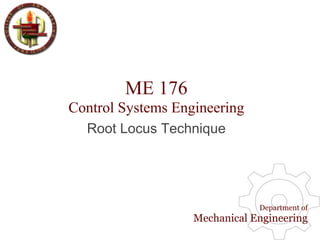
Lecture 15 ME 176 7 Root Locus Technique
- 1. ME 176 Control Systems Engineering Root Locus Technique Department of Mechanical Engineering
- 2. Introduction : Root Locus "... a graphical representation of closed loop poles as a system parameter is varied, is a powerful method of analysis and design for stability and transient response." "...real powere lies in its ability to provide for solutions for systems of order higher than 2." Department of Mechanical Engineering
- 3. Refining Sketch: Root Locus Rules: 1. Branches equal to closed-loop poles 2. Symentrical about real axis. 3. Left of odd number of real-axis finite open-loop poles and/or zeros. 4. Begins on finite/infinite poles, ends on finite/infinite zeros of G(s)H(s). 5. Approaches asymptotes as the locus approaches infinity: Refinements: 1. Break-away and break-in: 2. jw-Axis crossing using Routh-Hourwitz criterion. Department of Mechanical Engineering
- 4. Refining Sketch: Root Locus 3. Angles of Departure and Arrival: Root locus departs at complex open-loop poles and arrives at open-loop zeros at angels given by: assuming points close to such poles and zeros, summing all angles drawn from all poles and zeros will equal (2k+1)180. Zeros - postivive Poles - negative Department of Mechanical Engineering
- 5. Refining Sketch: Root Locus 4. Plotting and Calibrating the Root Locus: Evaluate the root locus at a point on the s- plane by first solving if that point yields a summation of angles (zero angles - pole angles) equal to an odd multiple of 180. Then calculate the gain by multiplying the pole lengths drawn to that point divided by product of zero lengths. Department of Mechanical Engineering
- 6. Refining Sketch: Root Locus Approximation to 2nd order systems 1. Higher-order poles are much farther into the left half of the s-plane than the dominant second order pair of poles. The response from a higher order pole does not appreciably change the transient response expected from the dominant second order pole. Department of Mechanical Engineering
- 7. Refining Sketch: Root Locus Approximation to 2nd order systems 2. Closed-loop zeros nea the closed loop second-order pole pair are nearly canceled by the close proximity of higher-order closed-loop poles. Department of Mechanical Engineering
- 8. Refining Sketch: Root Locus 4. Plotting and Calibrating the Root Locus: Evaluate the root locus at a point on the s- plane by first solving if that point yields a summation of angles (zero angles - pole angles) equal to an odd multiple of 180. Then calculate the gain by multiplying the pole lengths drawn to that point divided by product of zero lengths. Department of Mechanical Engineering
- 9. Refining Sketch: Root Locus Example: Do the following: 1. Sketch the root locus . 2. Find the imaginary-axis crossing. 3. Find the gain, K, at the jw-crossing. 4. Find the angles of departure. Department of Mechanical Engineering
- 10. Refining Sketch: Root Locus Example: Do the following: 1. Sketch the root locus . 2. Find the imaginary-axis crossing. 3. Find the gain, K, at the jw-crossing. 4. Find the angles of departure. Department of Mechanical Engineering
- 11. Refining Sketch: Root Locus Example: Do the following: 1. Sketch the root locus . 2. Find the imaginary-axis crossing. 3. Find the gain, K, at the jw-crossing. 4. Find the angles of departure. Department of Mechanical Engineering
- 12. Refining Sketch: Root Locus Lab Find F(s) at point s= -7+j9 Find G(s) at point s=-3+j0 Department of Mechanical Engineering
- 13. Refining Sketch: Root Locus Lab a. Sketch the root locus. b. Find Imaginary-axis crossing. c. Find K at jw-axis crossing. d. Find the break-in point. e. Find the point where the locus crosses the 0.5 damping ration line. f. Find the gain at the point where the locus crosses the 0.5 damping ration line. g. Find the range of gain, K, for which the system is stable. Department of Mechanical Engineering
- 14. Refining Sketch: Root Locus Lab Sketching Rules: 1. Branches: 2 2. Symmetric about real axis 3. Real-axis segment: Left of -2 pole 4. Start at poles, ends at zeros 5. Behavior at infinity: Sigma = 0 Theta = infinity Use Matlab: 6. Real-axis breakaway points 7. jw - crossing Department of Mechanical Engineering
- 15. Refining Sketch: Root Locus Lab Department of Mechanical Engineering
